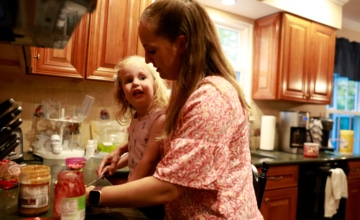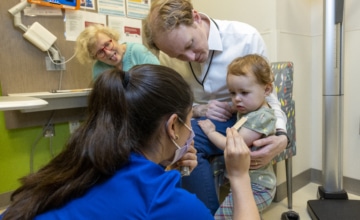Well-child visits—between the shots, the crying, the undressing/dressing again, and the diaper blowout (every.single.time.), it’s easy to get distracted! Here’s how to bring your A-game to your child’s next appointment.
1. Welcome home!
Every child should have a medical home—a clinic or pediatrician’s office where records are kept and your child is seen over time. This helps providers get to know you and your child and provide more individualized care.
2. Make a list of questions before you go.
It’s natural for new parents to have a long list of questions and concerns. Think through your questions and put them down on paper (or in your phone) so you can remember them during the visit. Not sure which questions are “most important”? Share your list with your provider and let her suggest where to start.
3. Ask anything.
There’s no question that’s “wrong” in the doctor’s office. Yes, it is totally normal to discuss your child’s poop! But you can also ask about behavior, physical milestones, nutrition, language development, and anything else that’s on your mind.
4. Get it in writing.
It’s hard to remember everything you hear at a medical appointment. It’s okay to bring along your co-parent, mom, or BFF to take notes and help with baby-wrangling. You can also ask your primary care provider to write down his most important advice—for example, how to give medication or what resources are available in the community to support your family. Some providers may have handouts on topics that come up a lot—like potty training or temper tantrums.
5. Ask about the best way to get in touch between visits.
Is there a number to call so you can speak to a provider 24/7? An email to request a prescription refill? An online portal where you can access information about your child’s medical history?
6. Ask when to call your doctor or nurse practitioner (and when to expect a call back).
The HealthySteps program says that it’s better to ask questions and get reassurance than to be home and worried. Talk to your health care provider about what symptoms should be a concern—for example, when should a fever mean a call to the office?
7. It’s not just about the baby.
Everything that’s happening in your household has an impact on your child. Let your provider know if you’re struggling with depression or anxiety, facing a difficult family issue, or having trouble with things like food and housing. Often children’s primary care providers can connect the whole family to supportive community resources.
8. Make your next appointment.
One of the most important things you can do after your child’s appointment is make the next one! The American Academy of Pediatrics recommends visits in baby’s first week and at 1, 2, 4, 6, 9, 12, 15, 18, 24, 30, and 36 months old. Keeping to this schedule ensures your child is up to date on all vaccinations and that you’re checking in at important milestones.
9. Own your expertise.
Your doctor or nurse practitioner has spent many years becoming an expert in their field—both in terms of education and in the number of babies they’ve seen. But as a mom or dad, you know YOUR baby best—what’s typical for him and what’s a concern. You bring all of your expertise to every visit and can speak up for your child as no one else can.





